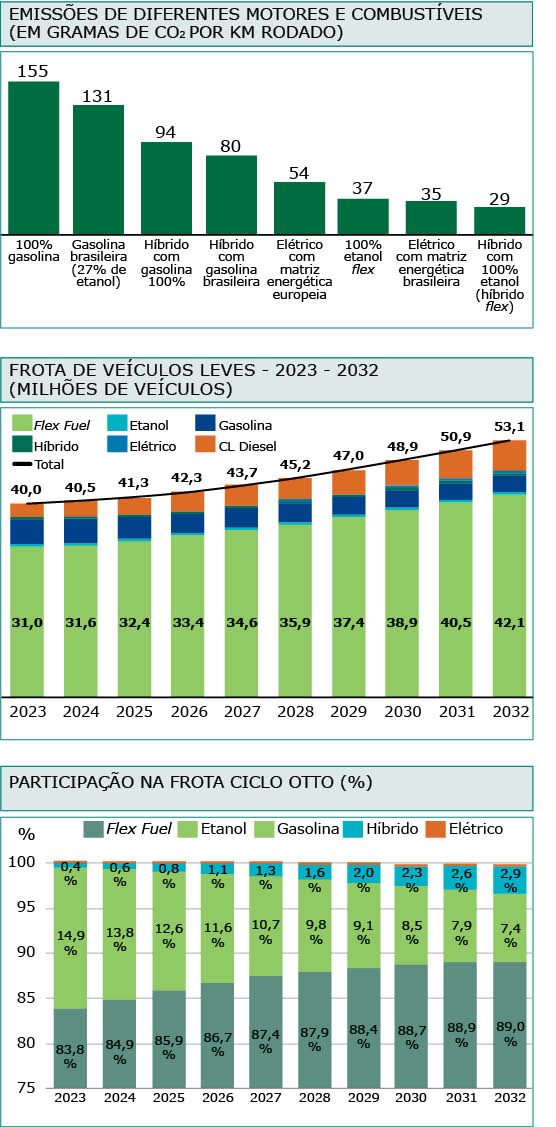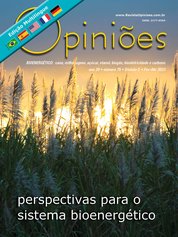Alexandre Enrico Silva Figliolino
Consultor-sócio da MB Agro e Consultor da XP para agronegócio
OpAA75
Se olharmos para um futuro mais distante, abrem-se ainda mais portas para a cana
Não temos dúvida da importância que sistemas integrados de produção de alimentos e energia, como o da cana-de-açúcar, terão no esforço mundial de descarbonização, hoje uma prioridade mundial. Não obstante o hemisfério norte estar partindo para a adoção do carro elétrico em massa, no Brasil, teremos, devido a uma série de fatores, ainda por um longo tempo, a supremacia dos veículos flex fuel na frota leve.
 Mas mesmo com a predominância na maior parte do mercado global de veículos elétricos, com repercussões inevitáveis no padrão do mercado brasileiro no longo prazo, o conceito de eletrificação pode ser combinado com o uso de etanol, por exemplo, pela utilização de carros com motor híbrido a etanol, como já ocorre hoje em modelo do fabricante Toyota, sendo esse modelo, aliás, o que apresenta a melhor performance disponível em emissão de gases do efeito estufa (GEE), como revelou uma análise feita pela Unica – União da Indústria de Cana-de-Açúcar e Bioenergia.
Mas mesmo com a predominância na maior parte do mercado global de veículos elétricos, com repercussões inevitáveis no padrão do mercado brasileiro no longo prazo, o conceito de eletrificação pode ser combinado com o uso de etanol, por exemplo, pela utilização de carros com motor híbrido a etanol, como já ocorre hoje em modelo do fabricante Toyota, sendo esse modelo, aliás, o que apresenta a melhor performance disponível em emissão de gases do efeito estufa (GEE), como revelou uma análise feita pela Unica – União da Indústria de Cana-de-Açúcar e Bioenergia.
Um veículo híbrido flex abastecido com etanol emite, do poço à roda, apenas 29 g CO2/km, ao passo que um veículo elétrico a bateria emite 37 g CO2/km, nas condições do grid brasileiro, com alta participação de fontes renováveis na matriz de energia elétrica brasileira. Essa diferença tende a ser ainda mais representativa fora do mercado brasileiro, sendo que, na Europa um veículo elétrico a bateria emite, em média, 54 g CO2/km.
Além disso, estão atualmente em estágio de desenvolvimento outras possibilidades de combinação entre etanol e veículos elétricos, como uso das tecnologias de célula de combustível a etanol. Nessas células, a eletricidade é quimicamente extraída da molécula de álcool para alavancar os motores elétricos dos veículos, que são mais eficientes que os motores a combustão.
Isso pode aumentar, de modo disruptivo, a eficiência do uso do etanol enquanto fonte de energia. Em outras palavras, o etanol, que já é uma solução competitiva para descarbonização de veículos leves, pode ter seu uso com eficiência muito maior no futuro. Pelo elevado teor de hidrogênio contido no etanol, levamos uma grande vantagem em relação ao resto do mundo, pois o Brasil já possui instalada a maior rede de distribuição do planeta, através dos mais de 41.700 postos de revenda distribuindo etanol em um país de dimensões continentais.
A oportunidade de protagonismo do etanol fica mais nítida ainda, no entanto, quando ele pode ir além do uso em veículos leves. A Europa, por exemplo, pretende estabelecer um mandato obrigatório de 2% de biocombustível no querosene de aviação a partir de 2025.
Outro fato extremamente auspicioso foi o etanol de cana-de-açúcar produzido no Brasil ser reconhecido pela Agência Ambiental Americana (EPA) como sustentável para a produção de bioquerosene de aviação. Se, hoje, o etanol é utilizado como substituto da gasolina, no futuro, poderá servir como plataforma para a produção de combustíveis sustentáveis para aviação (SAF, na sigla em inglês).
Uma destilaria no estado da arte consegue fabricar, já nesta década de 2020, uma grande variedade de produtos bioenergéticos. Entre eles, destacam-se o etanol de primeira geração (1G), proveniente da fermentação do caldo da cana-de-açúcar, e o etanol de segunda geração (2G), advindo da fermentação dos produtos lignocelulósicos da cana-de-açúcar (bagaço e palha), que substituem perfeitamente a gasolina.
Ela ainda gera biometano, oriundo da purificação do biogás obtido da vinhaça residual e substituto do gás natural, e pellets de lignina, provenientes da parte residual não fermentável do material lignocelulósico destinado à produção do etanol 2G e um biocombustível sólido de interesse do mercado europeu, sobretudo para reduzir a necessidade de queima de carvão mineral. E também produz bioeletricidade, gerada a partir do excedente da geração termelétrica com o bagaço da cana-de-açúcar não usado na produção de etanol 2G, que, despachável, pode substituir a fonte marginal entrante no grid brasileiro – por exemplo, o gás natural.
Em 2030, o aumento da eficiência de descarbonização, em comparação com o cenário de 2020, virá por ganhos de produtividade agrícola e pela implementação de tecnologias de captura e armazenamento de CO2 (BECCS) e reforçará muito essa cesta. E, se olharmos para um futuro mais distante, abrem-se ainda mais portas para a cadeia de valor da cana-de-açúcar brasileira. É que a biotecnologia deverá ter um papel crítico na produção econômica, e o açúcar é o principal insumo para processos biotecnológicos.




